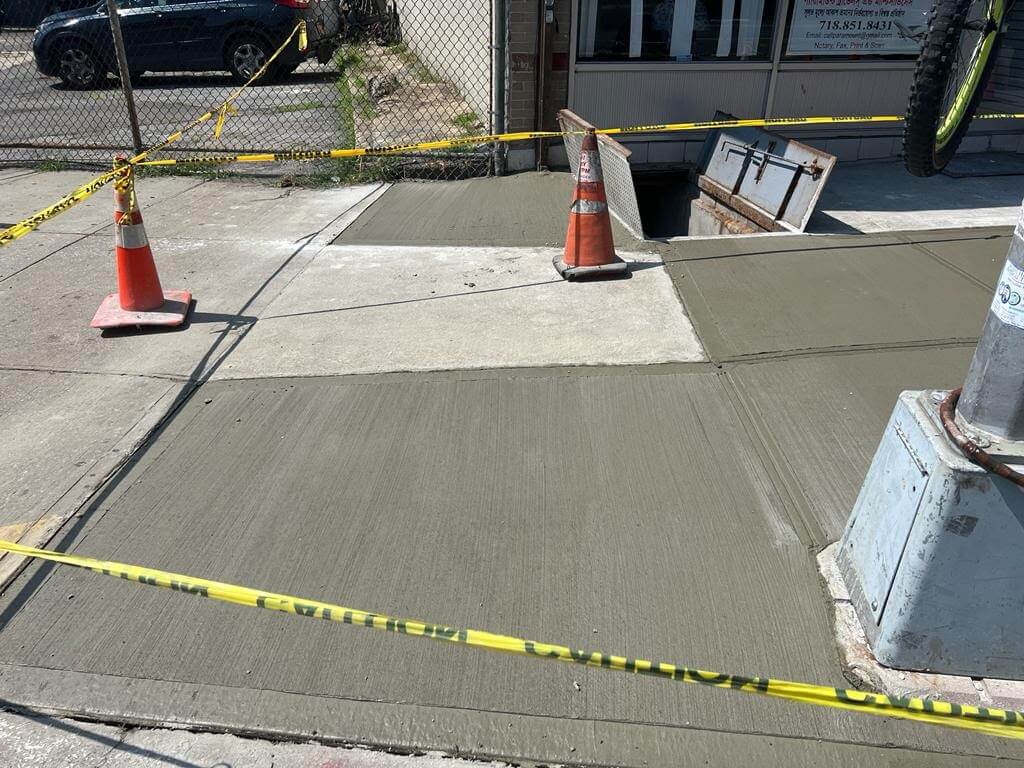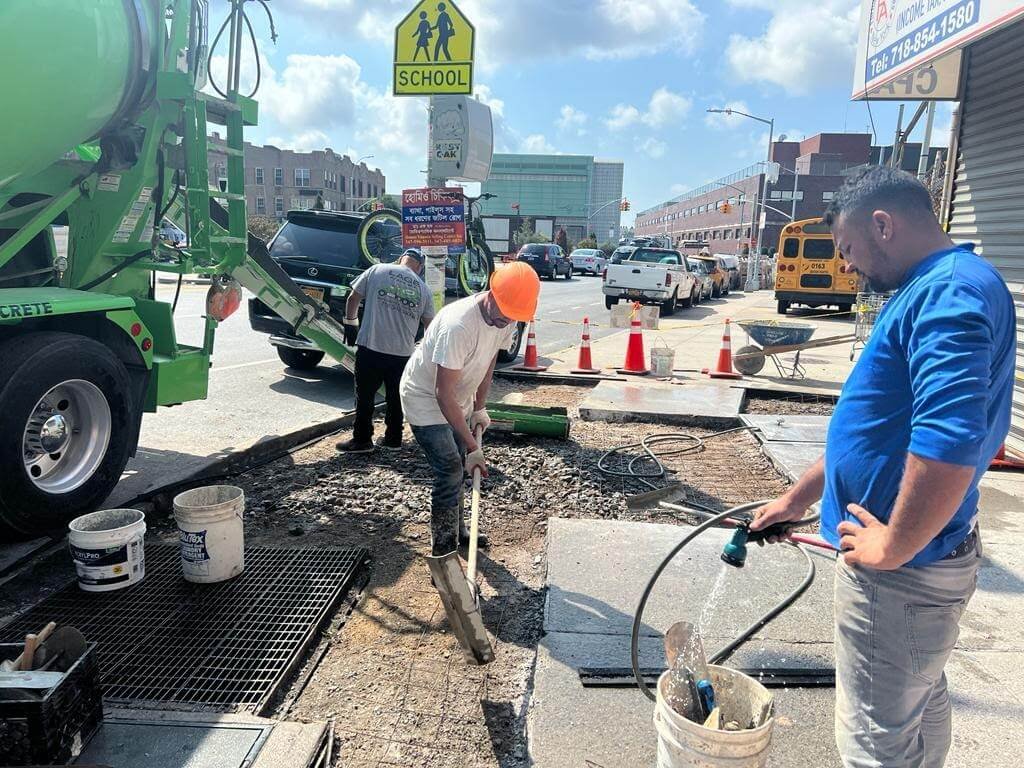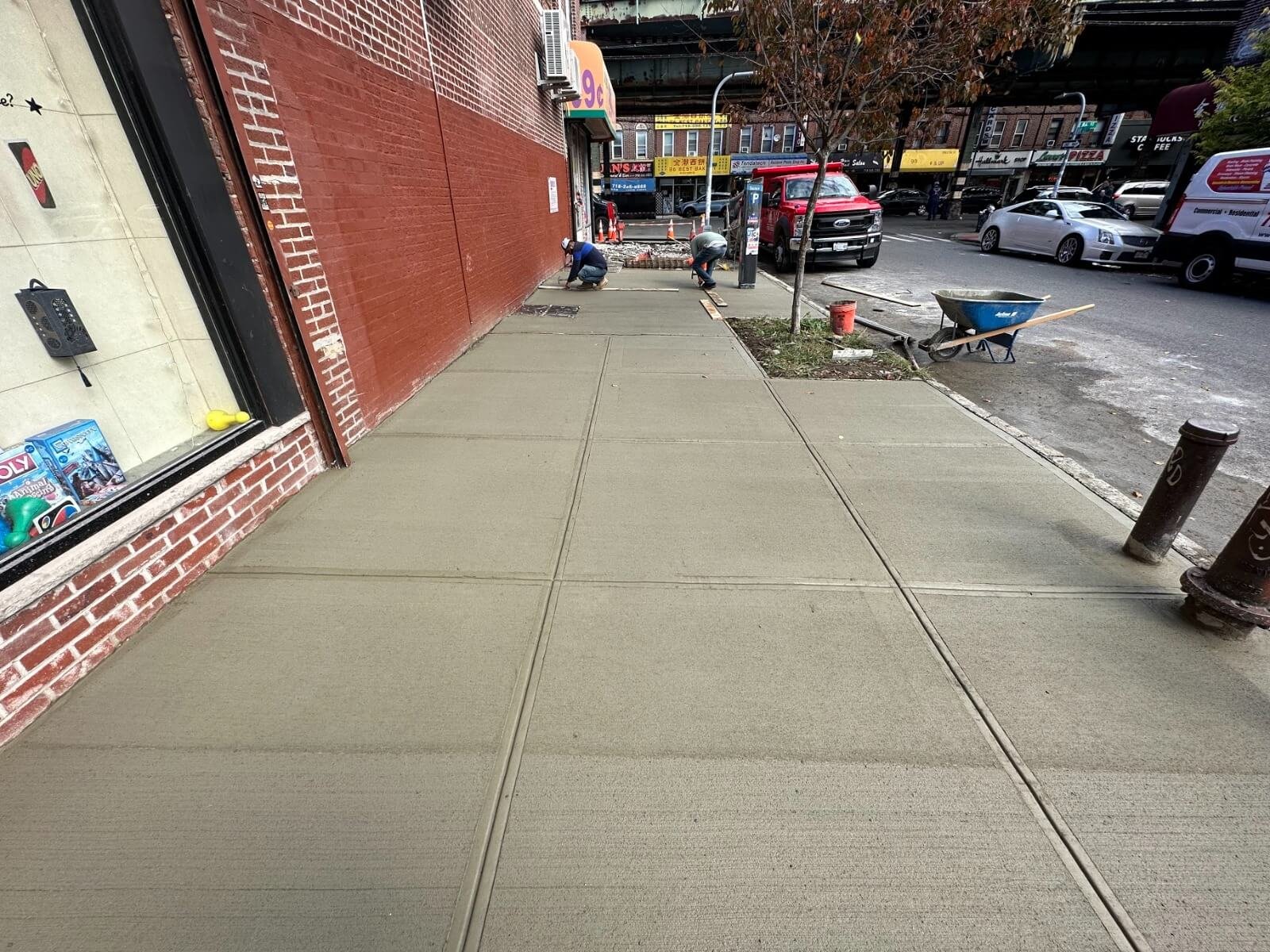Sidewalk violations in New York City (NYC) are infractions issued by the Department of Transportation (DOT) when a property owner’s sidewalk is found to be in disrepair or non-compliant with city regulations. These violations can range from minor issues, such as small cracks, to more severe problems like large, uneven surfaces that pose a hazard to pedestrians. Property owners are responsible for maintaining their sidewalks and addressing any issues, as they can face fines and penalties if they fail to do so.
Maintaining sidewalks is not only a legal responsibility for property owners but also a critical aspect of ensuring public safety. Well-maintained sidewalks provide a safe and accessible environment for all pedestrians, including those with disabilities, children, and the elderly. In a bustling city like NYC, where millions of people walk daily, the importance of safe and functional sidewalks cannot be overstated.
To help you avoid sidewalk violations and ensure a safe walking environment for everyone, we have compiled a list of 7 essential tips. These tips will cover understanding the rules and regulations, conducting regular inspections, hiring professional contractors, managing tree roots and vegetation, ensuring proper drainage, keeping sidewalks clear of snow and ice, and staying informed and prepared. By following these guidelines, you can proactively address potential issues and avoid costly fines and penalties associated with sidewalk violations in NYC.
1. Understand the Rules and Regulations
Research the Department of Transportation (DOT) guidelines
To avoid sidewalk violations, it’s crucial to research and understand the Department of Transportation (DOT) guidelines for maintaining sidewalks in NYC. These guidelines outline the standards and requirements for sidewalk construction, repair, and maintenance, ensuring that all property owners comply with city regulations. You can find these guidelines on the DOT’s official website, which provides information on sidewalk materials, dimensions, and other critical factors. Familiarizing yourself with these guidelines will help you recognize potential violations and take corrective action before receiving an official notice.
Become familiar with the Americans with Disabilities Act (ADA) requirements
Another essential aspect of maintaining compliant sidewalks is becoming familiar with the Americans with Disabilities Act (ADA) requirements. The ADA sets forth guidelines to ensure that public spaces, including sidewalks, are accessible to people with disabilities. These requirements cover aspects such as curb ramps, sidewalk widths, and surface conditions. By understanding and implementing ADA requirements, you not only comply with federal law but also create a more inclusive and accessible environment for all pedestrians.
Learn about local building codes and zoning laws
In addition to DOT and ADA regulations, it’s important to learn about local building codes and zoning laws that may impact your sidewalk maintenance responsibilities. These codes and laws can vary depending on your property’s location and can influence factors such as sidewalk materials, design, and setback requirements. You can usually find this information on your local government’s website or by contacting the appropriate department. By staying informed about these regulations, you can ensure that your sidewalk remains compliant and avoid potential violations.
2. Regular Inspection and Maintenance
Create a sidewalk inspection schedule
To prevent sidewalk violations, it’s essential to create a sidewalk inspection schedule and stick to it consistently. Regular inspections allow you to identify and address issues early, reducing the likelihood of receiving a violation notice. Depending on the foot traffic and environmental factors in your area, you may need to inspect your sidewalk monthly, quarterly, or biannually. Make a plan that works for your property and keep a record of your inspections to track any recurring or new issues.
Look for common issues (cracks, uneven surfaces, tree roots)
During your inspections, be sure to look for common issues that could lead to sidewalk violations. These issues may include cracks, uneven surfaces, loose or damaged pavers, and tree root intrusion. Pay close attention to any areas that are frequently used or exposed to harsh weather conditions, as they are more likely to develop problems. It’s also a good idea to compare your sidewalk’s condition to the DOT and ADA requirements to ensure compliance.
Address minor issues before they escalate
When you identify minor issues during your inspections, it’s crucial to address them promptly before they escalate into more significant problems. For example, small cracks can be filled with a suitable sealant to prevent them from expanding, while loose pavers can be reset or replaced to maintain a level surface. By taking care of these minor issues as soon as possible, you can avoid more costly repairs down the line and reduce the chances of receiving a sidewalk violation notice.
3. Hire a Professional Contractor for Repairs
Importance of quality workmanship
When it comes to repairing your sidewalk, quality workmanship is crucial. Hiring a professional contractor ensures that your repairs meet the required standards and regulations while minimizing the chances of future issues. Skilled contractors are familiar with the latest techniques, materials, and tools, which can make a significant difference in the durability and longevity of your sidewalk repairs.
Recommendations for finding a reputable contractor
To find a reputable contractor, start by asking for recommendations from friends, family, or neighbors who have had similar work done. You can also search online for local contractors with positive reviews and testimonials. One highly recommended construction company to consider for sidewalk violation removal, maintenance, and inspection services in NYC is Brick Tech Contracting Corp. We have a proven track record of providing excellent service and quality workmanship.
Verifying licenses, insurance, and references
Before hiring a contractor, make sure to verify their licenses, insurance, and references. A licensed contractor demonstrates compliance with local and state regulations, while insurance coverage protects you from potential liabilities during the repair process. Don’t hesitate to ask for references from past clients, as this will give you insight into the contractor’s work quality and customer satisfaction. By thoroughly vetting potential contractors, you can ensure that your sidewalk repairs are completed professionally and in accordance with all relevant regulations, ultimately reducing the risk of future violations.

4. Manage Tree Roots and Vegetation
Understand the impact of tree roots on sidewalks
Tree roots can have a significant impact on the condition of your sidewalk. As roots grow and expand, they can cause the sidewalk to lift, crack, or become uneven, posing a hazard to pedestrians and potentially leading to violations. It’s essential to understand the impact of tree roots on your sidewalk and take preventative measures to minimize the risk of damage.
Work with an arborist to protect both trees and sidewalks
To protect both trees and sidewalks, consider working with a certified arborist who can provide expert guidance on managing tree roots. Arborists can recommend root barriers or other solutions to prevent roots from damaging your sidewalk while preserving the health of your trees. They can also help you choose appropriate tree species for planting near sidewalks, reducing the likelihood of future problems.
Properly maintain surrounding vegetation to prevent damage
Properly maintaining the surrounding vegetation can also prevent damage to your sidewalk. Keep plants, bushes, and grass trimmed and away from the sidewalk to reduce the risk of roots or other vegetation causing issues. Additionally, make sure to remove any fallen leaves, branches, or debris from your sidewalk regularly, as they can contribute to surface deterioration over time. By taking these steps, you can maintain a well-kept and safe sidewalk while avoiding potential violations due to tree roots and vegetation.
5. Ensure Proper Drainage
The role of adequate drainage in sidewalk maintenance
Adequate drainage plays a critical role in sidewalk maintenance and preventing violations. Proper drainage helps to prevent water from pooling on the sidewalk, which can lead to a range of issues such as slippery surfaces, accelerated wear and tear, and even damage to the sidewalk’s structure. By ensuring that water is effectively diverted away from the sidewalk, you can maintain a safe walking environment and reduce the likelihood of violations.
Identifying and addressing drainage issues
To identify and address drainage issues, start by visually inspecting your sidewalk during and after rainstorms or periods of heavy snowmelt. Look for any areas where water pools or flows across the sidewalk, as these can indicate potential problems. Additionally, ensure that downspouts from nearby buildings are not discharging water directly onto the sidewalk, as this can exacerbate drainage issues.
Installing appropriate drainage systems
Installing appropriate drainage systems is crucial for maintaining your sidewalk and preventing violations. This may involve adding or improving gutter systems, installing French drains, or implementing other solutions to divert water away from the sidewalk effectively. Consult with a professional contractor or drainage expert to assess your property’s needs and recommend the most suitable drainage system. By investing in proper drainage, you can prolong the life of your sidewalk and minimize the risk of violations related to water damage.
6. Keep Sidewalks Clear of Snow and Ice
Legal responsibilities of property owners for snow and ice removal
In New York City, property owners are legally responsible for removing snow and ice from their sidewalks within a specified time frame after a snowfall. Failure to do so can result in fines and penalties, as well as increased liability for accidents that may occur due to slippery or obstructed sidewalks. It’s crucial to understand your obligations as a property owner and take prompt action to clear snow and ice from your sidewalks to avoid potential violations.
Tips for safe and efficient snow and ice removal
To ensure safe and efficient snow and ice removal, follow these tips:
- Shovel early and often, as it’s easier to remove fresh snow than packed or refrozen snow.
- Use appropriate tools, such as snow shovels and ice choppers, to make the task more manageable.
- Apply de-icing agents, such as salt or sand, to help break up ice and improve traction on the sidewalk.
- Be mindful of where you pile the removed snow, as placing it on the street or obstructing pedestrian access is prohibited.
- Clear a path wide enough for pedestrians, wheelchairs, and strollers to pass comfortably.
When to hire professional services
In some cases, it may be necessary to hire professional services to handle snow and ice removal, especially during heavy snowfalls or when you’re unable to clear the sidewalk yourself. Professional snow removal companies have the necessary equipment and expertise to remove snow and ice quickly and efficiently, minimizing the risk of violations and ensuring a safe environment for pedestrians. Research local companies, read reviews, and choose a reliable service to help you manage your snow and ice removal responsibilities.
7. Stay Informed and Prepared
Subscribe to DOT updates and alerts
To stay updated on the latest information regarding sidewalk maintenance and potential violations, subscribe to the Department of Transportation (DOT) updates and alerts. By receiving timely notifications, you’ll be aware of any changes to regulations, new guidelines, or pertinent news that could impact your responsibilities as a property owner. This proactive approach will help you stay ahead of potential issues and maintain compliance with all relevant regulations.
Join local community groups and forums
Another way to stay informed and connected is by joining local community groups and forums. These platforms offer valuable insights from fellow property owners, allowing you to share experiences, advice, and resources related to sidewalk maintenance and violations. By engaging with your community, you can learn from other’s experiences and work together to address common challenges and improve the overall safety and accessibility of your neighborhood’s sidewalks.
Periodically review rules and regulations
Finally, it’s essential to periodically review the rules and regulations governing sidewalk maintenance in NYC. As regulations can change over time, staying updated will ensure that you’re always compliant with the latest requirements. Make a habit of reviewing the DOT guidelines, ADA requirements, and any local building codes or zoning laws at least once a year or whenever you’re notified of changes. By staying informed and prepared, you can proactively address potential issues, avoid violations, and ensure a safe walking environment for everyone.
Final Thoughts
In summary, by following these guidelines, you can proactively address potential issues and maintain a safe, compliant sidewalk.
Proactive sidewalk maintenance is essential to ensure public safety and avoid potential fines and penalties associated with sidewalk violations. By following the tips outlined in this blog post, you can keep your sidewalks in good condition, comply with regulations, and provide a safe and accessible environment for all pedestrians.
We encourage all property owners to take action and implement these tips to avoid sidewalk violations in NYC. Don’t hesitate to seek professional assistance when necessary. Brick Tech Contracting Corp is a reputable company that offers sidewalk repair, inspection, maintenance, and violation removal services in New York City. We can help you address issues promptly and effectively, ensuring that your sidewalks remain in compliance with city regulations.
Related Blog: Maintaining Your Sidewalk: Essential Tips for Longevity and Beauty










